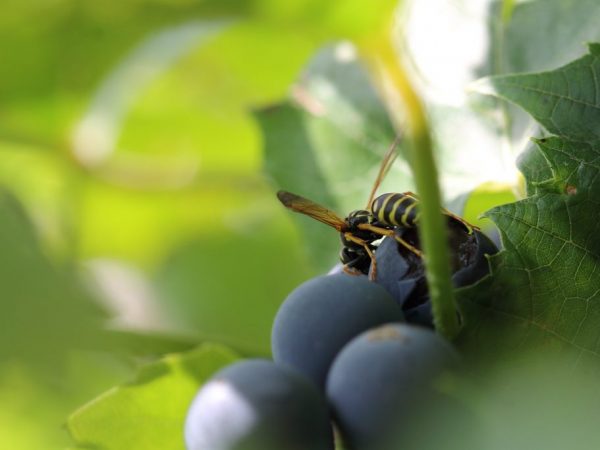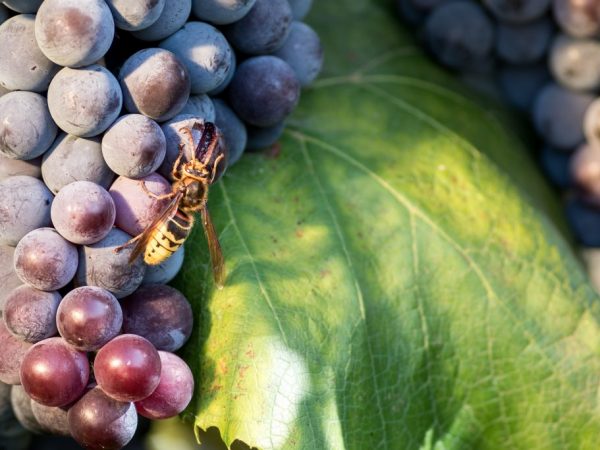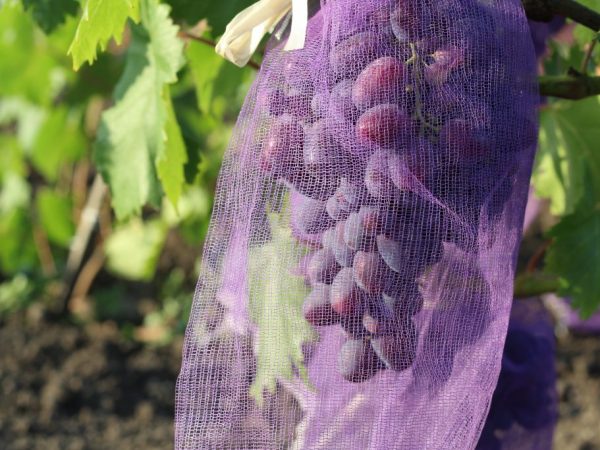How to deal with wasps on grapes
Vineyards suffer from seasonal diseases and insect infestations. These factors compromise the quality of the crop. Wasp control on grapes is carried out every year. Insects choose sweet varieties with an early ripening period. For the destruction of pests, drugs and mechanical traps are used.

Wasp control on grapes
Wasps in the vineyard
Grapes are susceptible to attacks by bees during the ripening period. Wasps and other pests feed only on ripe and sweet berries. Sour varieties that ripen in late autumn are less likely to suffer from insect infestations. Pests threaten bunches growing on open land.
All varieties with a thin peel can suffer from pest attacks. If the wasps have already damaged part of the crop, effective control methods are used. The method of destroying pests is selected according to the location of the vineyard and its variety.
Basic methods of struggle
Protection of the grapes begins before the fruiting period. Before planting and pruning the vine, the land plot is cleared. If there are no hornets' nests nearby, they additionally dig up the soil. These activities help to destroy insect larvae. Pests multiply quickly, so the vineyards should be inspected every 2 weeks.
How to save grapes from wasps if they have already appeared on the land:
- destroy nests where bees swarm;
- divert their attention from the vineyard;
- catch pests with traps;
- scare away insects with sound.
If the wasps do not leave the land after the basic methods are carried out, insecticides and other insect-killing drugs are used.
It is impossible to completely get rid of insects: in the first months they are beneficial, destroying caterpillars and harmful beetles. Protection from wasps is needed only towards the end of summer, when the bunches are fully ripe.
Destruction of nests
The fastest and most radical way to get rid of the problem with your own hands is to destroy the nest of wasps or bees. It is especially difficult to find a nest on large plots of land located close to forests or orchards. Before destroying a bee nest, a person is prepared:
- open areas of the body need protection: if you anger a swarm of bees, you can get hurt;
- the method of destroying the nest is chosen: you cannot simply knock down or stir up the hive;
- a chemical agent is selected that will quickly destroy the entire swarm.
Burning a nest of bees is ineffective. Most of the swarm will have time to leave the nest and find new shelter near the vineyard. Weakened individuals will further harm the crop: bees will need more food to restore the population.
During the ripening of the crop, the nest is sprayed with dichlorvos (it is better to use a spray can). To prevent the pests from hiding in the trellis, the holes are carefully closed. For this, polyurethane foam is used.
Distraction

Wasps can be distracted
A distraction method is used to protect the crop.Wasps eat the fruits of not only grapes, but also other crops. To preserve fragrant bunches, the vine is planted near flowering fruit trees.
During the ripening period, vessels with syrup are placed next to the plant, which also attract bees.
This trick is useful only during the ripening period of a small amount of the crop.
Scare away the smell
A strong smell will help keep the grapes from wasps. The bee is a sensitive insect that does not react well to heavy odors.
The best protection for vineyards in the garden is liquid smoke. It is a concentrated solution that mimics the smell of natural smoking.
Condensed smoke from deciduous trees is used for the preparation of the drug. The form of release of the agent to save the vineyard from pests is a powder or a water-based substance. Less commonly, liquid smoke is released with alcohol.
The fight with such a substance is effective only until the moment when the bee tastes the fruit. If there are a lot of bees, the smoke does not scare away all individuals. Spraying the vine with substances with a pronounced odor helps to save the harvest.
For these purposes, use coniferous infusion or garlic juice concentrate. This method is effective, but after spraying, the fruits can absorb some of the liquid, so the taste and aroma of the berries will be spoiled.
Setting traps
If pests are eating the crop, the most effective way to control them is by setting traps. Traps are hand-made devices that pests fall into. The trap lures pests with a sweet smell. The basis for it is a plastic bottle or other transparent container in the house. The device is installed in the vineyard or along the outer perimeter (the number of traps depends on the size of the land plot).
Traps for grapes from wasps and bees are prepared according to a simple principle:
- the top of the plastic bottle is cut off;
- the remaining piece of plastic is used as the bottom, and the bottle is turned over;
- the parts are tightly connected;
- homemade bait is poured into the device.
For a DIY trap, a honey or sugar mixture is useful. Resourceful gardeners use fermented jam. To prepare a simple trap, you need 0.5 liters of regular beer, 2 tablespoons of sugar. The ingredients are mixed and poured into the device.
A solution of white wine and mint syrup can also help fight pests. In the vineyard, the bait is periodically changed (dead pests are removed and a fresh sweet solution is poured). Homemade devices are efficient and safe for the crop.
Bunch bags

Nets will not let insects harm
Wasp-proof grape pouches are efficient and simple devices. They are pouches or meshes (their size is adjustable). With bags, it is possible to ward off insects from the crop without additional costs and without the use of chemicals.
Self-adjusting mesh helps keep flies, bees and birds away from the fruit. If the pests do not find a food source, they leave the nest and fly to other land plots (bags for protecting grapes from wasps serve as effective prevention before the bunches ripen).
The bags allow you to protect the crop from:
- pests;
- sunburn;
- mechanical damage;
- bad weather (strong wind).
A net to ward off pests is bought in a store or made by hand. Mosquito-proof fabric is used for reusable bags: bags are sewn from it in the form of an inverted herringbone with ties at the top. After disinfection (after harvest), the nets are reused.
Poisoned baits
Treating the vineyard or spraying the vine does not fully protect the crop. Poisoned baits are prepared according to the principle of a trap: the top of the bottle is cut off, as for a conventional trap. A solution prepared in water and Aktara is poured inside.
In order for the pests to get into the bait faster, sticks are brought to the bottom of the bottle in the form of a "ladder". There is no need to clean the device: the wasps fly away on their own, but quickly die after using the bait.
Wasps extermination through poisoned fruits
Quick protection of grapes from wasps without traps and other devices - these are poisoned fruits that are eaten by insects. A plastic wrap is laid under the vine, on which crushed fruits are laid (it is better to take pears or plums). The fruits are pretreated with an insecticide.
The fight against bees in this way begins at the moment when the fruits change color, ripen. The poisoned fruit helps to preserve the presentation of the grapes and quickly destroy most of the swarm.
Conclusion
To protect grapes from wasps, they use poisonous treatment, traps, and scare off with a smell. If you treat the vineyard with concentrates, the aroma and taste of the fruit will deteriorate, therefore, use safe nets or poisoned fruits.
Safe pest control methods help preserve the crop and keep it looking good. To save grapes from wasps, drugs are used only in extreme cases.

